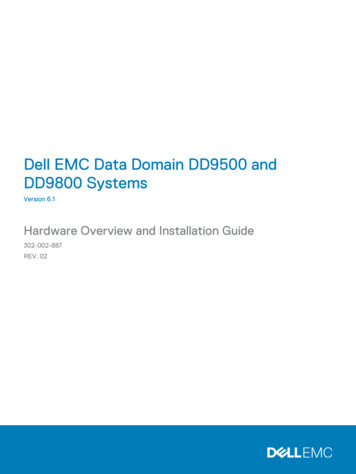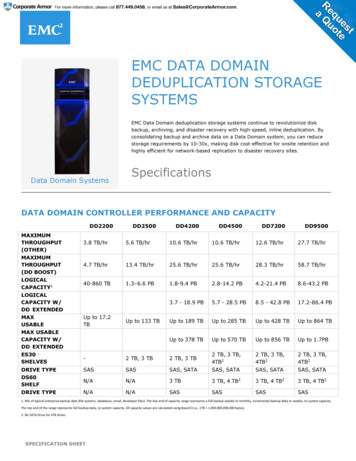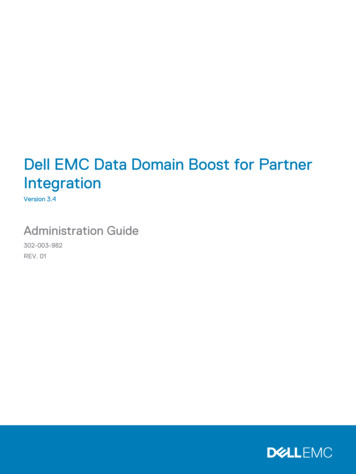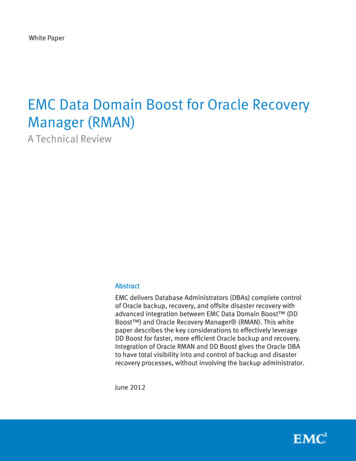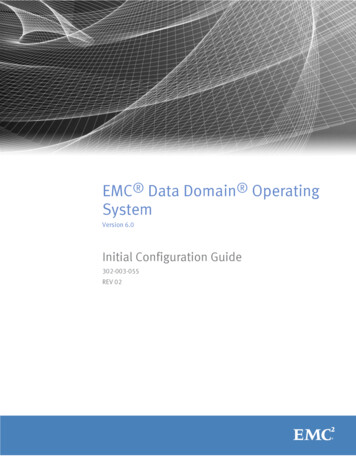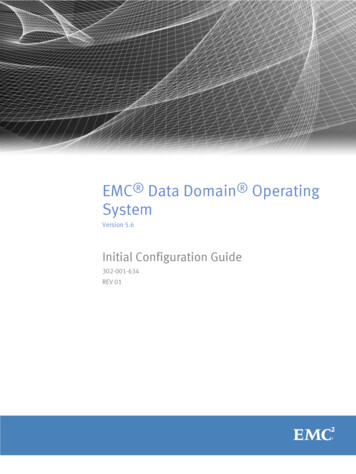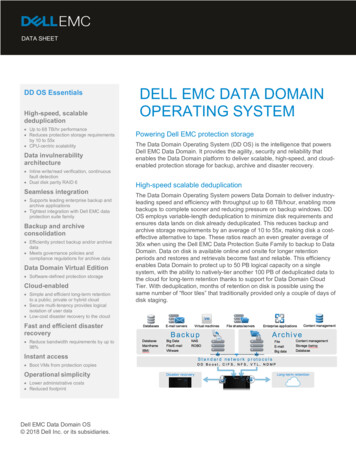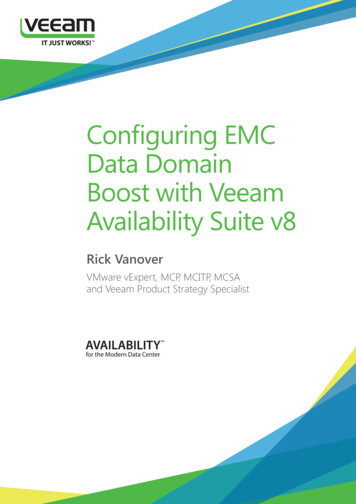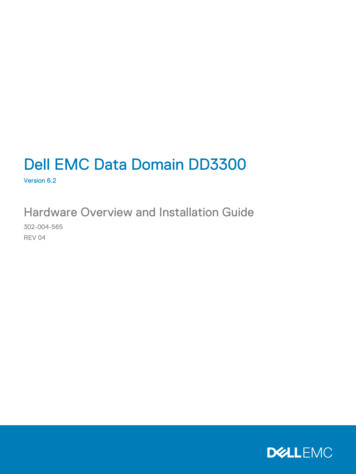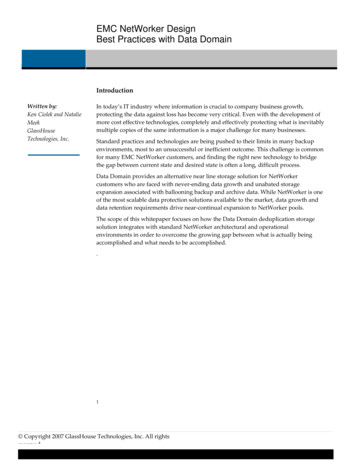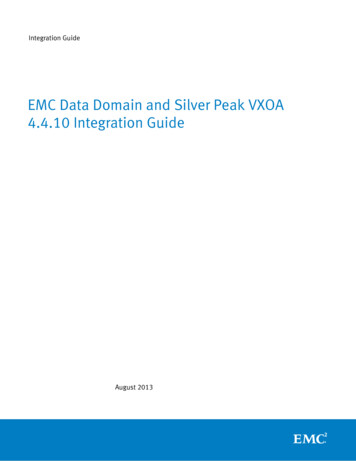
Transcription
Integration GuideEMC Data Domain and Silver Peak VXOA4.4.10 Integration GuideAugust 2013
Copyright 2013 EMC Corporation. All Rights Reserved.EMC believes the information in this publication is accurate asof its publication date. The information is subject to changewithout notice.The information in this publication is provided “as is.” EMCCorporation makes no representations or warranties of any kindwith respect to the information in this publication, andspecifically disclaims implied warranties of merchantability orfitness for a particular purpose.Use, copying, and distribution of any EMC software described inthis publication requires an applicable software license.For the most up-to-date listing of EMC product names, see EMCCorporation Trademarks on EMC.com.All other trademarks used herein are the property of theirrespective owners.Part Number: 302-999-817 Rev. 01EMC Data Domain and Silver Peak Integration Guide2
Table of ContentsAbout this document . 4Audience . 4Related documents . 4Overview . 4Replication Challenges . 5Solution Components . 7EMC Data Domain. 7Silver Peak VXOA . 7Network Memory . 7Network Integrity . 8Network Acceleration . 8Secure Content Architecture . 8Global Management System . 8Customer Example: Global Telecommunications Company . 8Replication across the United States using a private line . 8WAN . 9Throughput . 9Deploying Silver Peak with Data Domain . 10Recommended Versions . 10Silver Peak Configuration . 10Silver Peak Deployments Options . 10Sizing Silver Peak Appliances . 11Data Domain System Configuration . 11Replication Settings . 11Bandwidth Throttle . 12Data Domain Static Route . 13Monitoring Performance . 15Silver Peak Performance Monitoring . 15Data Domain Performance Monitoring . 17EMC Data Domain and Silver Peak Integration Guide3
About this documentNote: Prior to performing this integration, be sure to consult the EMC Data DomainProduct Compatibility Matrix on Powerlink or the EMC Data Domain support portal(https://support.datadomain.com) for the versions of Silver Peak and DD OS certifiedfor use with the respective products.This document explains how to deploy EMC Data Domain deduplication storagesystems with Silver Peak VXOA WAN optimization appliances.The instructions provided in this document by EMC are for customer convenience andare not warranted or supported by EMC. EMC expects users to customize installationof third-party software for use at a particular site, but EMC is not responsible for theusability of third-party software after installation.This document is applicable for the following versions of Silver Peak: Silver Peak VXOA 4.4.10 and higherThis document is applicable for the following versions of the Data Domain operatingsystem (DD OS): EMC Data Domain systems running DD OS versions 5.1.0.9 and higherAudienceThis paper is intended for customers, technical field consultants, and customerengineers who have familiarity with either Silver Peak and/or Data Domainoperations.Related documentsThe Data Domain and Silver Peak documents referred to in this guide provideadditional information for configuring and using Data Domain and Silver Peak.The Silver Peak documents are available at: http://www.silverpeak.com/Support/user docs.asp.Documentation for the Data Domain system is available at:https://my.datadomain.com/documentation and on Powerlink.OverviewEMC Data Domain deduplication storage systems optimize storage efficiency throughthe use of deduplication and compression of data at rest. When the deduplicated andcompressed data is replicated using Data Domain, it is a common belief that WANoptimization is not required because a smaller amount of data is being sent acrossthe WAN. However, in addition to limited bandwidth, at least two factors can affectthe ability for replication to meet customer RPOs over a Wide Area Network (WAN):replication distance (latency) and quality of the WAN itself (packet loss and out oforder packets). By solving many of the underlying network problems that plagueEMC Data Domain and Silver Peak Integration Guide4
replicating over distance, Silver Peak VXOA, when combined with EMC Data DomainReplicator, enables customers to move more data, over a longer distance, and in lesstime. In this paper we will describe the benefits that Silver Peak’s Virtual AccelerationOpen Architecture, VXOA, provides for the Data Domain system; provide deploymentand configuration examples; detail best practices; and illustrate expectedperformance improvements based on a customer deployment.Replication ChallengesData replication helps to address the core requirement of disaster recovery:safeguarding data against natural and man-made disasters. The key to beingprepared for an event that requires the use of data at a remote site is maintaining aconsistent Recovery Point Objective (RPO).RPO is easily defined as the amount of data that will be lost in the event of a disasterrecovery event. For example, if the RPO is defined as 3 hours and a disaster isdeclared at 12:00 P.M., any data created between 9:00 A.M. and 12:00 P.M. will belost. Based on business or compliance requirements the RPO can be anything fromdays, to hours, minutes, or even seconds.RPO is directly affected by the throughput of the data that is being replicated. If datais replicated over high-speed, dedicated links within a campus or a metro area, RPOis easily met. However, as replication is stretched over a longer distance, three factorsimpact throughput and thus RPO: Distance (latency) can significantly affect replication performance because thelonger the distance, the longer the remote DR site requires to respond to theprimary site during the replication process. The impact of latency alone can be afactor of 10-20X slower replication. WAN quality (amount of packet loss) can also affect replication performance –even a 0.1% loss (typical of MPLS WAN links) can decrease replicationperformance significantly Bandwidth is also a limiting factor for replication throughput. Simply put, if thereis more data to replicate in a given period of time and bandwidth isn’t sufficient,the RPO will be missed.For many storage replication solutions, all three of the above issues plaguereplication performance and the ability for customers to meet RPOs. For Data Domain,one of the key issues (amount of bandwidth) is already addressed since the data isalready deduplicated and therefore does not need to be sent over the WAN. Insituations where Data Domain replication shares the WAN pipe with other replication(or non-replication) applications, however, bandwidth can still be a constraint (for theother applications).Silver Peak VXOA, deployed as either a virtual or physical appliance, quickly andeasily repairs the above WAN quality problems, removes the impact of latency, andEMC Data Domain and Silver Peak Integration Guide5
eliminates many bandwidth bottlenecks. The result is dramatically increasedreplication throughput for maintaining RPOs.For example, a 1 Gbps WAN with 0.1% of packet loss and 80 ms of latency will belimited to approximately 7.5 Mbps per TCP session. The limitation comes from thecombination of latency and packet loss. When packets are dropped TCP will limit thethroughput (congestion control) while recovering from the error and resending thedata that was lost. It is the combination of congestion control, retransmission, andlatency that cause the throughput limitations seen when replicating across distanceover a WAN with congestion or loss. Figure 1 illustrates the maximum throughputacross a WAN with different packet loss and latency combinations.Figure 1Packet Loss ProbabilitySilver Peak VXOA will complement Data Domain replication in the following scenarios: Replication occurs over longer distances, resulting in increased latency (anddecreased replication throughput). The WAN suffers from poor quality (packet loss and/or out of order packets). The WAN is shared with multiple applications with the potential for congestion. Any combination of the above.In summary, using Silver Peak with Data Domain allows customers to: Replicate at greater distances, while maintaining replication throughput. Repair network problems, loss, and out-of-order, allowing the full use of availablebandwidth for replication, even across the Internet.EMC Data Domain and Silver Peak Integration Guide6
Solution ComponentsThis solution can be deployed using any EMC Data Domain hardware and any SilverPeak VXOA physical or virtual software appliance.EMC Data DomainEMC Data Domain deduplication storage systems reduce the amount of disk capacityrequired to store and protect enterprise data with inline deduplication andcompression. Redundant data is identified, as it is stored, reducing the amount ofcapacity required by 10-30X on average. After data is stored on the Data Domainsystem, it can be replicated for disaster recovery by using DD Replicator software.DD Replicator software provides network-efficient and encrypted replication fordisaster recovery (DR), remote office data protection, and multi-site tapeconsolidation. DD Replicator software vaults or asynchronously replicates only thecompressed and deduplicated data over the wide area network (WAN), makingnetwork-based replication economically and operationally feasible.Silver Peak VXOASilver Peak provides a robust WAN optimization solution that addresses thebandwidth, latency, and packet loss issues that are common to most enterpriseenvironments. Silver Peak's optimization techniques are all performed in real-timeand primarily at the network (IP) layer to ensure maximum performance across thewidest range of applications and WAN environments.Figure 2Silver Peak VXOASilver Peak appliances leverage the following Virtual Acceleration Open Architecture(VXOA) technology components to accelerate all enterprises applications in a secureand reliable fashion.Network MemorySilver Peak has a patent-pending solution for disk-based WAN deduplication.Network Memory inspects all traffic that is sent between clients and servers, storingEMC Data Domain and Silver Peak Integration Guide7
information as a local instance in Silver Peak appliances. Repetitive information isdelivered locally rather than sent across the WAN, improving application performanceand WAN utilization. Cross-flow payload and header compression provide additionalgains on first-time data transfers and non-repetitive traffic.Network IntegritySilver Peak employs a variety of real-time techniques to address packet deliveryissues common to shared WAN technologies, such as MPLS and IP VPN. Theseinclude adaptive Forward Error Correction (FEC) and Packet Order Correction (POC) toovercome dropped and out-of-order packets, and advanced Quality of Service (QoS)techniques to prioritize traffic and guarantee network resources.Network AccelerationSilver Peak mitigates the impacts of latency across the WAN by using various TCPacceleration techniques, like adjustable window sizing and selectiveacknowledgements, as well as CIFS acceleration techniques, such as read-aheadsand write-behinds. These tools help to overcome inherent chattiness that canotherwise hamper application performance across a WAN.Secure Content Architecture Silver Peak products are built on a Secure Content Architecture that enablesenterprises to deploy WAN acceleration with complete confidence. The Silver Peaksolution incorporates the latest in encryption technology to protect data at all times:at rest and in transit across the WAN. In addition, Silver Peak makes it easy toconfigure, enforce, and monitor security policies from a central location through theSilver Peak Global Management System (GMS), and employs mechanisms to ensurethat security does not come at the expense of network performance or scalability.The result is end-to-end secure WAN acceleration.Global Management SystemGlobal Management System (GMS) is a powerful platform for the deployment,management, and monitoring of a Silver Peak-enabled Wide Area Network (WAN).GMS gives IT managers detailed visibility into all aspects of application deliveryacross a distributed enterprise, including WAN performance statistics, applicationanalysis, and tools for the configuration and management of Silver Peak appliances.With Silver Peak, enterprises can deliver business critical applications centrally in asecure, scalable, and cost effective manner.Customer Example: Global Telecommunications CompanyReplication across the United States using a private lineIn this use case the customer is using Data Domain Replicator to replicate severalData Domain systems simultaneously across the United States using a private line.EMC Data Domain and Silver Peak Integration Guide8
Typically a private line offers the highest available throughput due to an absence ofout-of-order and dropped packets. This customer faced the problem of high latency,limiting throughput and causing replication jobs to take an excessively long amountof time, resulting in missed RPOs.Deploying Silver Peak VXOA allowed the customer to use all of the availablebandwidth on the WAN by overcoming the effects of latency. Before Silver Peak wasdeployed, each Data Domain system was able to use approximately 80 Mbps ofbandwidth. After Silver Peak VXOA was deployed, the amount of bandwidth utilizedby each array increased to 1 Gbps, allowing the entire 10 Gbps private line to be fullyutilized, which in turn allowed the customer to meet their RPO.Note that the Data Domain system allows optimization of the networking connectionby changing the network setting for Delay and Bandwidth, resulting in higherthroughput when using the Data Domain Replicator. (Refer to the EMC Data DomainOperating System Administration Guide for instructions.) The networking settings forthis customer had been optimized, but still suffered from high amounts of latency,resulting in the Transmission Control Protocol (TCP) reducing the throughput.Deploying Silver Peak VXOA accelerates Data Domain Replicator without anyadditional tuning on the Data Domain arrays.Silver Peak VXOA is also able to provide additional benefits by deduplicatingreplication data across the multiple Data Domain systems as it is replicating. Notethat this deduplication occurs only while the data is being replicated and does notreplace the deduplication that each Data Domain system provides for data at rest.AcceleratedThroughput in Mbps per arrayUn-Accelerated020040060080010001200WAN 10 Gbps private line stretching across the United States 90 ms of latency 0% packet loss and out-of-orderThroughput Without Silver Peak VXOA – 80 Mbps per array With Silver Peak VXOA – 1 Gbps per arrayEMC Data Domain and Silver Peak Integration Guide9
Deploying Silver Peak with Data DomainRecommended Versions Silver Peak VXOA 4.4.10 and higher Data Domain OS 5.1.0.9 and higherSilver Peak ConfigurationUse the default VXOA settings shown in Table 1 unless the WAN connection hasconsistent levels of packet loss. When packet loss is variable, Forward ErrorCorrection (FEC) should be set to Auto. This lets VXOA dynamically adjust the numberof parity packets that are used to recover from the loss. When packet loss isconsistent, a static Forward Error Correction can be used to help maintain throughput.Note: If you specify a fixed value for Forward Error Correction, some bandwidth isalways used for parity packets. For example, if you specify 1:10 for FEC, 10% of theavailable bandwidth is used for parity.VXOA includes an application definition for Data Domain systems. By default, alltraffic is optimized with the default settings. Except for adjusting Forward ErrorCorrection as described above, do not change these default settings.Table 1Default Silver Peak SettingsSettingDefault for Data Domain SystemsNetwork Memory ModeBalancedPayload CompressionEnabledTCP AccelerationEnabledForward Error Correction (FEC)DisabledSilver Peak Deployments OptionsYou can deploy Silver Peak VXOA to optimize all network traffic or just specificapplications. When you deploy Silver Peak to optimize the network, you use SilverPeak in bridge or router mode; this requires changes to the network. When you deploySilver Peak for specific applications, no network changes are required. Anapplication-specific Silver Peak deployment with a Data Domain system uses a staticroute that is configured on the Data Domain system. See “Data Domain Static Route”on page 13. The choice of deployment method does not impact the performance ofthe Data Domain system.For more information on Silver Peak deployment options, see the Silver Peak NetworkDeployment Guide.EMC Data Domain and Silver Peak Integration Guide10
Sizing Silver Peak AppliancesSilver Peak VXOA can be deployed as a physical appliance (NX) or virtual instance(VX/VRX). Silver Peak’s virtual products can be deployed on any hypervisor (VMware,Microsoft Hyper-V, Xen and KVM) on any third party hardware that meets theminimum requirements.Silver Peak offers two separate virtual appliance product lines: VX-Series are for general purpose WAN optimization and are sized by WANbandwidth VRX-Series are replication-specific and are sized by throughput (GB/TB/hr) tomeet a RPO.SilverPeak VXModelWAN 0VX90002Mbps4 Mbps10 Mbps
EMC Data Domain systems running DD OS versions 5.1.0.9 and higher Audience This paper is intended for customers, technical field consultants, and customer engineers who have familiarity with either Silver Peak and/or Data Domain operations. Related documents The Data Domain and Silver Peak documents referred to in this guide provide

